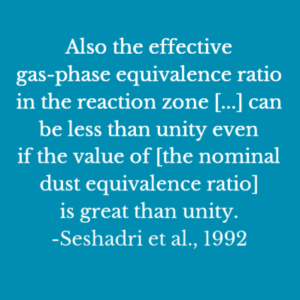1-Sentence-Summary: A mathematical model demonstrates flame structure and burning velocities of premixed particle-cloud flames.
Authors: K. Seshadri, A.L. Berlad, and V. Tangirala
Read in: Three Minutes
Favourite quote from the paper:

The current authors develop a mathematical model of premixed flame propagation through particle clouds. The governing equations assume the flame has a three-zone structure: an initial preheat zone were vaporization occurs, a thin reaction zone which is dominated by combustion chemistry and diffusion, and a post-flame convection zone were diffusion is no longer important. This work is a precursor to Bidabadi, et al. 2010 who separated the first zone into distinct preheat and vaporization sections.
The governing equations are solved using asymptotic analysis. The particles are assumed to produce 100% methane gas during vaporization. The effects of radiation and nonadiabitc combustion are assumed negligible, and a single step combustion reaction is used. The fluid and particles are assumed to be in thermal equilibrium at all times, and a unity Lewis number is assumed.
Results from the model demonstrate laminar burning velocity and maximum flame temperature for different nominal equivalence ratios. The effect of nominal equivalence ratio on the actual gas equivalence ratio achieved in the reaction zone is also explored. In all cases the nominal equivalence ratio is larger than 1.0, and diffusion flames surrounding individual particles are assumed to cover adjacent particles (e.g., see Bidabadi, et al. 2010 and Williams, 1985)
Three of the main findings from this paper are:
- Laminar burning velocities between 3 and 15 cm/s were predicted using the mathematical model.
- The flames are fuel lean in the reaction zone up to nominal equivalence ratios of approximately 6.0.
- Particle vaporization and burning in the post-flame zone may play an important role in flame propagation.
The following sections outline the main findings in more detail. The interested reader is encouraged to view the complete article at the link provided below.
Finding #1: Particle cloud burning velocities are estimated between 3 and 15 cm/s
The authors use the model to predict burning velocities and flame temperatures for particle clouds. Burning velocities from 3 cm/s to 5 cm/s are calculated for 100 µm particles between nominal equivalence ratios of 1.0 and 6.0. This compares to a burning velocity range from 9 cm/s to 15 cm/s for 10 µm particles, between equivalence ratios of 1.0 and 3.0. As shown by Bidabadi, et al. 2010, these results compare qualitatively to a four-zone flame model and the experimental data of Proust, 2006.
Maximum flame temperatures are also predicted with the mathematical model. In all cases the maximum flame temperature was less than a hypothetical gas flame temperature at the same equivalence ratio. The particle cloud temperature approached the gas flame temperature as the particle size is reduced and the nominal equivalence ratio is increased.
Finding #2: Flames are fuel lean in the reaction zone even though nominal particle concentration is rich
The effective gas phase equivalence ratio in the reaction zone is plotted as a function of the nominal particle equivalence ratio. The results demonstrate that the flames are all fuel lean, even though the nominal particle concentration is very high. For example 10 µm particles require a nominal equivalence ratio of 2.0 to reach an effective ratio of 0.75. 100 µm particles require a nominal equivalence ratio of 6 to achieve the same effective gas concentration.
Finding #3: Vaporization and burning in the post-flame zone may play an important role for dust flames
In all cases the amount of dust vaporized and eventually consumed in the flame is a small fraction of the total fuel. Therefore, dust continues to vaporized and react behind the flame front in the post-flame zone. This feature is distinctly different than gas flames and causes increased flame thickness. The authors also caution that the impact of using more detailed chemistry modeling may substantially change the flame structure, especially in the post-flame region.
My Personal Take-Aways From
“The Structure of Premixed Particle-Cloud Flames”
This paper illustrates in very understandable terms the potential structure of premixed particle-cloud flames, including the relative roles of preheating, vaporization, and reaction. It also gives an extensive list of original contributions in this area including Essenhigh and Csaba, 1962, Smoot et al., 1977, Mitani, 1981, Joulin, 1981, Smoot, 1979, Joulin and Deshaies, 1986, Joulin and Eudier, 1989, Berlad et al., 1990 , Berlad et al., 1991, and Coffee et al., 1983. Future posts will focus on reviewing some of these papers.
The finding that the effective fuel concentration is substantially lower than the total fuel in the dust cloud is a critical topic in understanding dust flame propagation. This feature is what makes dust flames different than gas flames and also leads to several of the complexities in studying these systems. An additional difficulty occurs at lower dust concentration, where individual diffusion flames no longer surround neighboring particles. Understanding of this feature is required to explain and predict the flammability limits of dust clouds. Both of these topics are interesting areas of study for dust flame propagation moving forward.
Full Citation: [bibtex file=references.bib key=Seshadri1992]
[otw_shortcode_button href=”http://www.sciencedirect.com/science/article/pii/001021809290019L” size=”medium” icon_position=”left” shape=”square”]> > Get The Article[/otw_shortcode_button]
